Analysis of Risk Management Strategies at the LEGO Group
VerifiedAdded on 2020/05/16
|11
|3601
|47
AI Summary
The LEGO Group's approach to risk management involves integrating strategic planning with robust frameworks that adapt rather than adopt standard models. This has enabled them to address operational challenges effectively while fostering innovation and maintaining competitive advantage. By leveraging insights from sources such as Andersen, Coombs & Holladay, and others, the company has demonstrated a commitment to managing risks in a way that supports sustainable growth and organizational resilience. This assignment will analyze these strategies by examining theoretical foundations and empirical examples drawn from relevant literature.
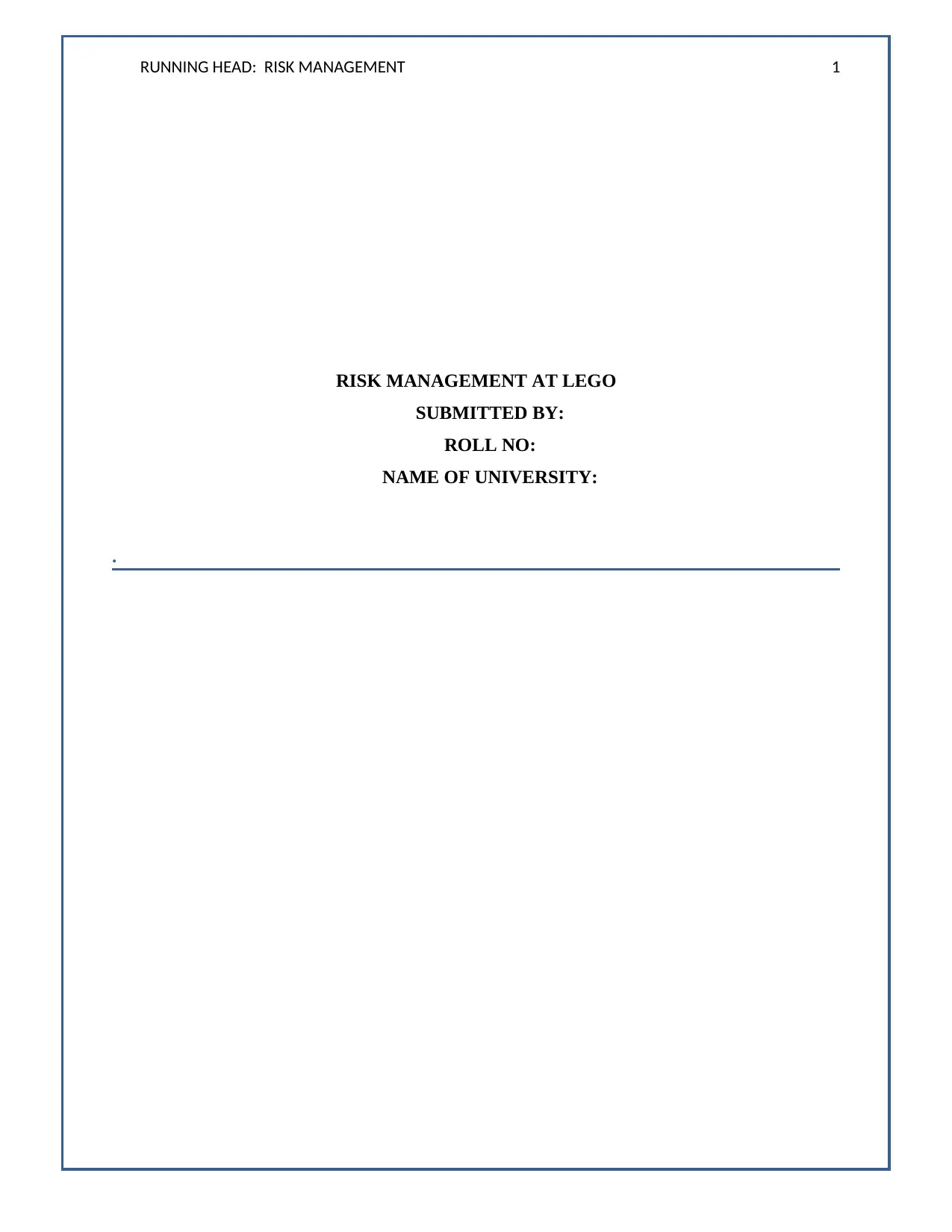
RUNNING HEAD: RISK MANAGEMENT 1
RISK MANAGEMENT AT LEGO
SUBMITTED BY:
ROLL NO:
NAME OF UNIVERSITY:
.
RISK MANAGEMENT AT LEGO
SUBMITTED BY:
ROLL NO:
NAME OF UNIVERSITY:
.
Paraphrase This Document
Need a fresh take? Get an instant paraphrase of this document with our AI Paraphraser
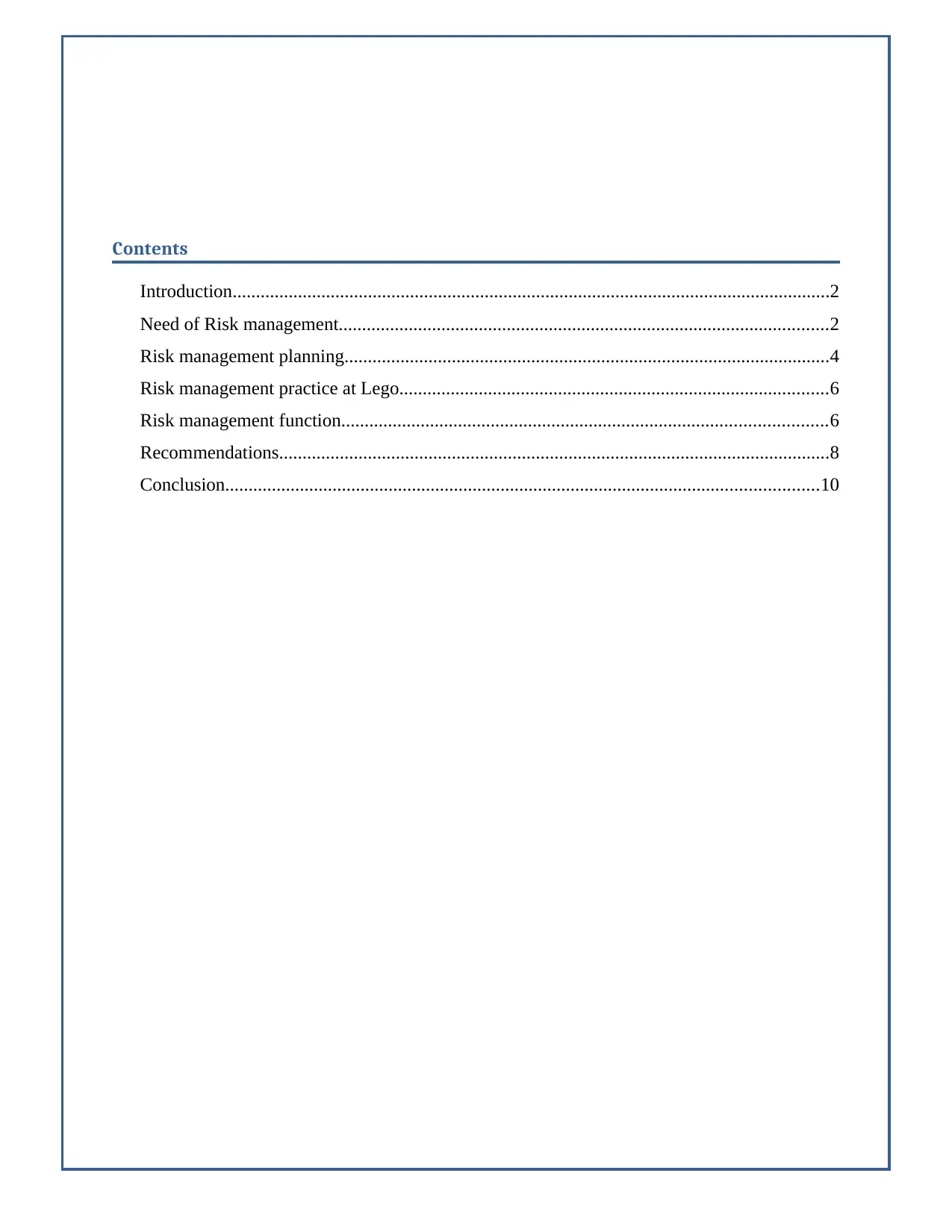
Contents
Introduction................................................................................................................................2
Need of Risk management.........................................................................................................2
Risk management planning........................................................................................................4
Risk management practice at Lego............................................................................................6
Risk management function........................................................................................................6
Recommendations......................................................................................................................8
Conclusion...............................................................................................................................10
Introduction................................................................................................................................2
Need of Risk management.........................................................................................................2
Risk management planning........................................................................................................4
Risk management practice at Lego............................................................................................6
Risk management function........................................................................................................6
Recommendations......................................................................................................................8
Conclusion...............................................................................................................................10
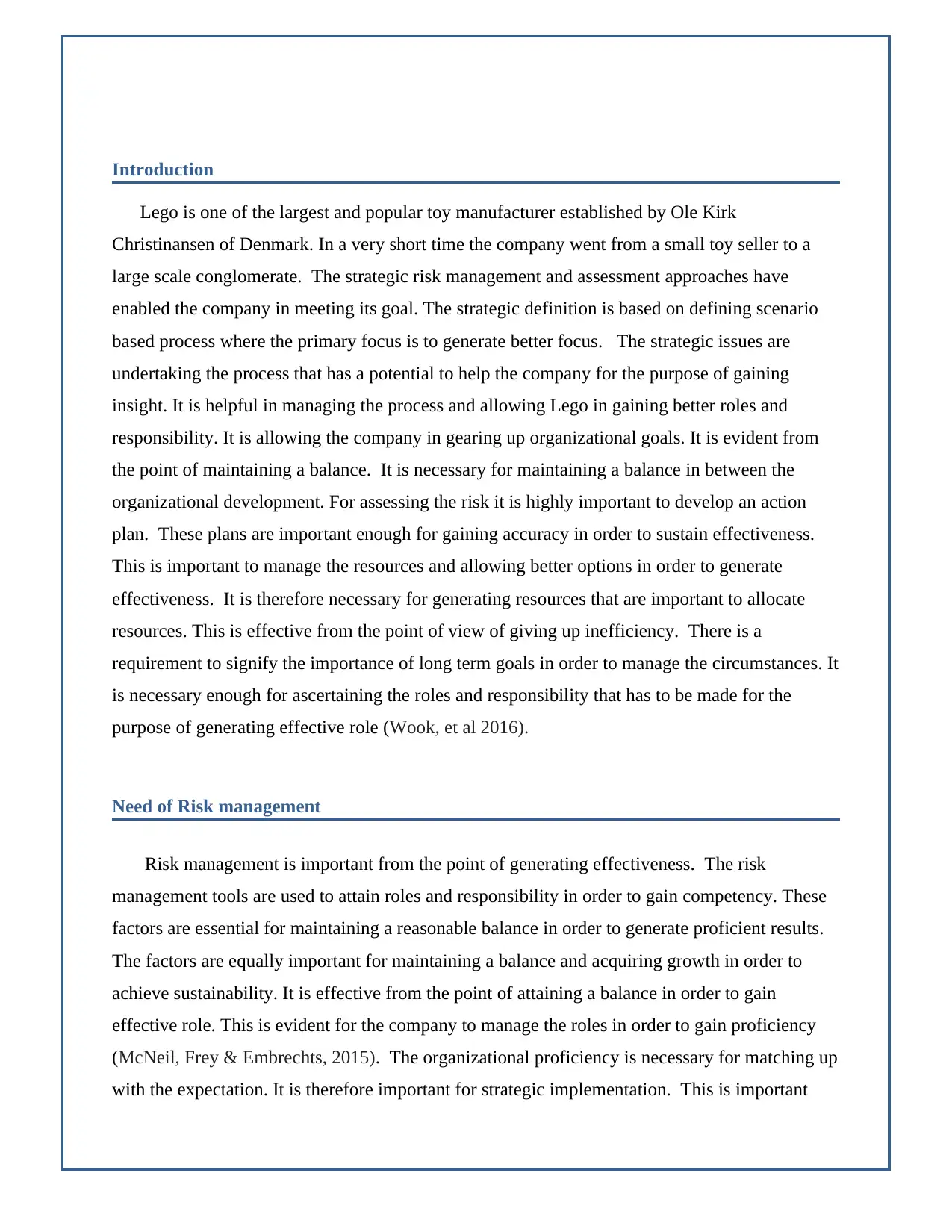
Introduction
Lego is one of the largest and popular toy manufacturer established by Ole Kirk
Christinansen of Denmark. In a very short time the company went from a small toy seller to a
large scale conglomerate. The strategic risk management and assessment approaches have
enabled the company in meeting its goal. The strategic definition is based on defining scenario
based process where the primary focus is to generate better focus. The strategic issues are
undertaking the process that has a potential to help the company for the purpose of gaining
insight. It is helpful in managing the process and allowing Lego in gaining better roles and
responsibility. It is allowing the company in gearing up organizational goals. It is evident from
the point of maintaining a balance. It is necessary for maintaining a balance in between the
organizational development. For assessing the risk it is highly important to develop an action
plan. These plans are important enough for gaining accuracy in order to sustain effectiveness.
This is important to manage the resources and allowing better options in order to generate
effectiveness. It is therefore necessary for generating resources that are important to allocate
resources. This is effective from the point of view of giving up inefficiency. There is a
requirement to signify the importance of long term goals in order to manage the circumstances. It
is necessary enough for ascertaining the roles and responsibility that has to be made for the
purpose of generating effective role (Wook, et al 2016).
Need of Risk management
Risk management is important from the point of generating effectiveness. The risk
management tools are used to attain roles and responsibility in order to gain competency. These
factors are essential for maintaining a reasonable balance in order to generate proficient results.
The factors are equally important for maintaining a balance and acquiring growth in order to
achieve sustainability. It is effective from the point of attaining a balance in order to gain
effective role. This is evident for the company to manage the roles in order to gain proficiency
(McNeil, Frey & Embrechts, 2015). The organizational proficiency is necessary for matching up
with the expectation. It is therefore important for strategic implementation. This is important
Lego is one of the largest and popular toy manufacturer established by Ole Kirk
Christinansen of Denmark. In a very short time the company went from a small toy seller to a
large scale conglomerate. The strategic risk management and assessment approaches have
enabled the company in meeting its goal. The strategic definition is based on defining scenario
based process where the primary focus is to generate better focus. The strategic issues are
undertaking the process that has a potential to help the company for the purpose of gaining
insight. It is helpful in managing the process and allowing Lego in gaining better roles and
responsibility. It is allowing the company in gearing up organizational goals. It is evident from
the point of maintaining a balance. It is necessary for maintaining a balance in between the
organizational development. For assessing the risk it is highly important to develop an action
plan. These plans are important enough for gaining accuracy in order to sustain effectiveness.
This is important to manage the resources and allowing better options in order to generate
effectiveness. It is therefore necessary for generating resources that are important to allocate
resources. This is effective from the point of view of giving up inefficiency. There is a
requirement to signify the importance of long term goals in order to manage the circumstances. It
is necessary enough for ascertaining the roles and responsibility that has to be made for the
purpose of generating effective role (Wook, et al 2016).
Need of Risk management
Risk management is important from the point of generating effectiveness. The risk
management tools are used to attain roles and responsibility in order to gain competency. These
factors are essential for maintaining a reasonable balance in order to generate proficient results.
The factors are equally important for maintaining a balance and acquiring growth in order to
achieve sustainability. It is effective from the point of attaining a balance in order to gain
effective role. This is evident for the company to manage the roles in order to gain proficiency
(McNeil, Frey & Embrechts, 2015). The organizational proficiency is necessary for matching up
with the expectation. It is therefore important for strategic implementation. This is important
⊘ This is a preview!⊘
Do you want full access?
Subscribe today to unlock all pages.

Trusted by 1+ million students worldwide
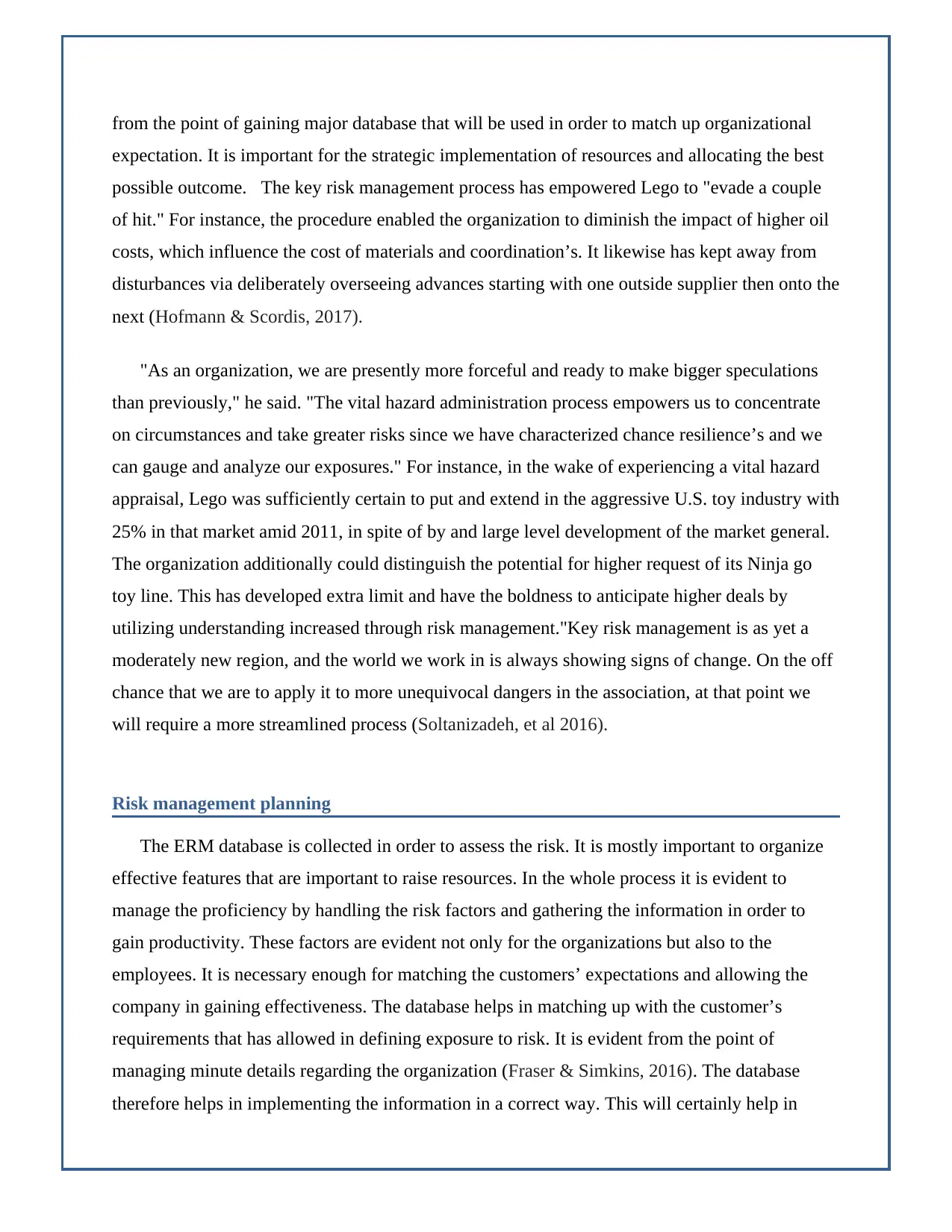
from the point of gaining major database that will be used in order to match up organizational
expectation. It is important for the strategic implementation of resources and allocating the best
possible outcome. The key risk management process has empowered Lego to "evade a couple
of hit." For instance, the procedure enabled the organization to diminish the impact of higher oil
costs, which influence the cost of materials and coordination’s. It likewise has kept away from
disturbances via deliberately overseeing advances starting with one outside supplier then onto the
next (Hofmann & Scordis, 2017).
"As an organization, we are presently more forceful and ready to make bigger speculations
than previously," he said. "The vital hazard administration process empowers us to concentrate
on circumstances and take greater risks since we have characterized chance resilience’s and we
can gauge and analyze our exposures." For instance, in the wake of experiencing a vital hazard
appraisal, Lego was sufficiently certain to put and extend in the aggressive U.S. toy industry with
25% in that market amid 2011, in spite of by and large level development of the market general.
The organization additionally could distinguish the potential for higher request of its Ninja go
toy line. This has developed extra limit and have the boldness to anticipate higher deals by
utilizing understanding increased through risk management."Key risk management is as yet a
moderately new region, and the world we work in is always showing signs of change. On the off
chance that we are to apply it to more unequivocal dangers in the association, at that point we
will require a more streamlined process (Soltanizadeh, et al 2016).
Risk management planning
The ERM database is collected in order to assess the risk. It is mostly important to organize
effective features that are important to raise resources. In the whole process it is evident to
manage the proficiency by handling the risk factors and gathering the information in order to
gain productivity. These factors are evident not only for the organizations but also to the
employees. It is necessary enough for matching the customers’ expectations and allowing the
company in gaining effectiveness. The database helps in matching up with the customer’s
requirements that has allowed in defining exposure to risk. It is evident from the point of
managing minute details regarding the organization (Fraser & Simkins, 2016). The database
therefore helps in implementing the information in a correct way. This will certainly help in
expectation. It is important for the strategic implementation of resources and allocating the best
possible outcome. The key risk management process has empowered Lego to "evade a couple
of hit." For instance, the procedure enabled the organization to diminish the impact of higher oil
costs, which influence the cost of materials and coordination’s. It likewise has kept away from
disturbances via deliberately overseeing advances starting with one outside supplier then onto the
next (Hofmann & Scordis, 2017).
"As an organization, we are presently more forceful and ready to make bigger speculations
than previously," he said. "The vital hazard administration process empowers us to concentrate
on circumstances and take greater risks since we have characterized chance resilience’s and we
can gauge and analyze our exposures." For instance, in the wake of experiencing a vital hazard
appraisal, Lego was sufficiently certain to put and extend in the aggressive U.S. toy industry with
25% in that market amid 2011, in spite of by and large level development of the market general.
The organization additionally could distinguish the potential for higher request of its Ninja go
toy line. This has developed extra limit and have the boldness to anticipate higher deals by
utilizing understanding increased through risk management."Key risk management is as yet a
moderately new region, and the world we work in is always showing signs of change. On the off
chance that we are to apply it to more unequivocal dangers in the association, at that point we
will require a more streamlined process (Soltanizadeh, et al 2016).
Risk management planning
The ERM database is collected in order to assess the risk. It is mostly important to organize
effective features that are important to raise resources. In the whole process it is evident to
manage the proficiency by handling the risk factors and gathering the information in order to
gain productivity. These factors are evident not only for the organizations but also to the
employees. It is necessary enough for matching the customers’ expectations and allowing the
company in gaining effectiveness. The database helps in matching up with the customer’s
requirements that has allowed in defining exposure to risk. It is evident from the point of
managing minute details regarding the organization (Fraser & Simkins, 2016). The database
therefore helps in implementing the information in a correct way. This will certainly help in
Paraphrase This Document
Need a fresh take? Get an instant paraphrase of this document with our AI Paraphraser
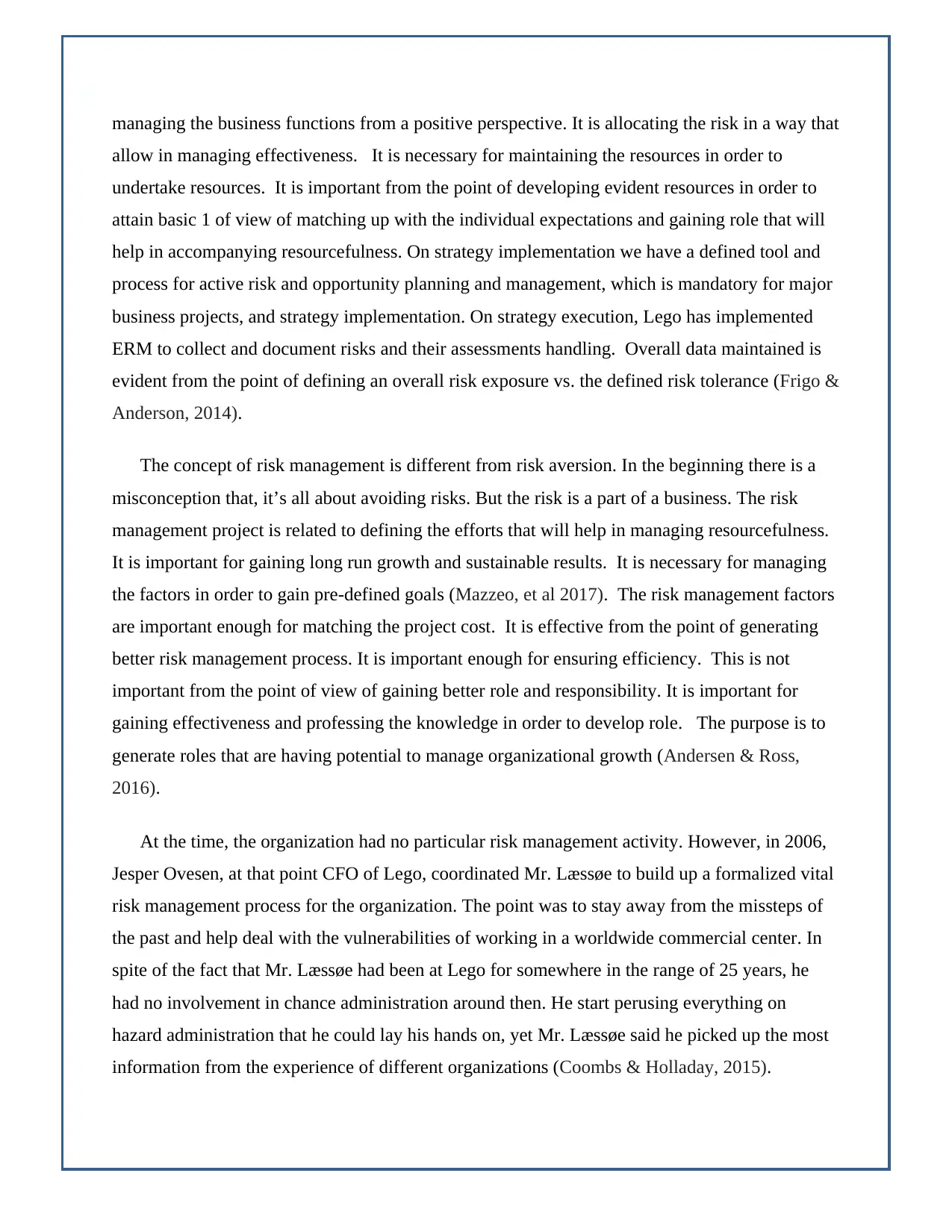
managing the business functions from a positive perspective. It is allocating the risk in a way that
allow in managing effectiveness. It is necessary for maintaining the resources in order to
undertake resources. It is important from the point of developing evident resources in order to
attain basic 1 of view of matching up with the individual expectations and gaining role that will
help in accompanying resourcefulness. On strategy implementation we have a defined tool and
process for active risk and opportunity planning and management, which is mandatory for major
business projects, and strategy implementation. On strategy execution, Lego has implemented
ERM to collect and document risks and their assessments handling. Overall data maintained is
evident from the point of defining an overall risk exposure vs. the defined risk tolerance (Frigo &
Anderson, 2014).
The concept of risk management is different from risk aversion. In the beginning there is a
misconception that, it’s all about avoiding risks. But the risk is a part of a business. The risk
management project is related to defining the efforts that will help in managing resourcefulness.
It is important for gaining long run growth and sustainable results. It is necessary for managing
the factors in order to gain pre-defined goals (Mazzeo, et al 2017). The risk management factors
are important enough for matching the project cost. It is effective from the point of generating
better risk management process. It is important enough for ensuring efficiency. This is not
important from the point of view of gaining better role and responsibility. It is important for
gaining effectiveness and professing the knowledge in order to develop role. The purpose is to
generate roles that are having potential to manage organizational growth (Andersen & Ross,
2016).
At the time, the organization had no particular risk management activity. However, in 2006,
Jesper Ovesen, at that point CFO of Lego, coordinated Mr. Læssøe to build up a formalized vital
risk management process for the organization. The point was to stay away from the missteps of
the past and help deal with the vulnerabilities of working in a worldwide commercial center. In
spite of the fact that Mr. Læssøe had been at Lego for somewhere in the range of 25 years, he
had no involvement in chance administration around then. He start perusing everything on
hazard administration that he could lay his hands on, yet Mr. Læssøe said he picked up the most
information from the experience of different organizations (Coombs & Holladay, 2015).
allow in managing effectiveness. It is necessary for maintaining the resources in order to
undertake resources. It is important from the point of developing evident resources in order to
attain basic 1 of view of matching up with the individual expectations and gaining role that will
help in accompanying resourcefulness. On strategy implementation we have a defined tool and
process for active risk and opportunity planning and management, which is mandatory for major
business projects, and strategy implementation. On strategy execution, Lego has implemented
ERM to collect and document risks and their assessments handling. Overall data maintained is
evident from the point of defining an overall risk exposure vs. the defined risk tolerance (Frigo &
Anderson, 2014).
The concept of risk management is different from risk aversion. In the beginning there is a
misconception that, it’s all about avoiding risks. But the risk is a part of a business. The risk
management project is related to defining the efforts that will help in managing resourcefulness.
It is important for gaining long run growth and sustainable results. It is necessary for managing
the factors in order to gain pre-defined goals (Mazzeo, et al 2017). The risk management factors
are important enough for matching the project cost. It is effective from the point of generating
better risk management process. It is important enough for ensuring efficiency. This is not
important from the point of view of gaining better role and responsibility. It is important for
gaining effectiveness and professing the knowledge in order to develop role. The purpose is to
generate roles that are having potential to manage organizational growth (Andersen & Ross,
2016).
At the time, the organization had no particular risk management activity. However, in 2006,
Jesper Ovesen, at that point CFO of Lego, coordinated Mr. Læssøe to build up a formalized vital
risk management process for the organization. The point was to stay away from the missteps of
the past and help deal with the vulnerabilities of working in a worldwide commercial center. In
spite of the fact that Mr. Læssøe had been at Lego for somewhere in the range of 25 years, he
had no involvement in chance administration around then. He start perusing everything on
hazard administration that he could lay his hands on, yet Mr. Læssøe said he picked up the most
information from the experience of different organizations (Coombs & Holladay, 2015).
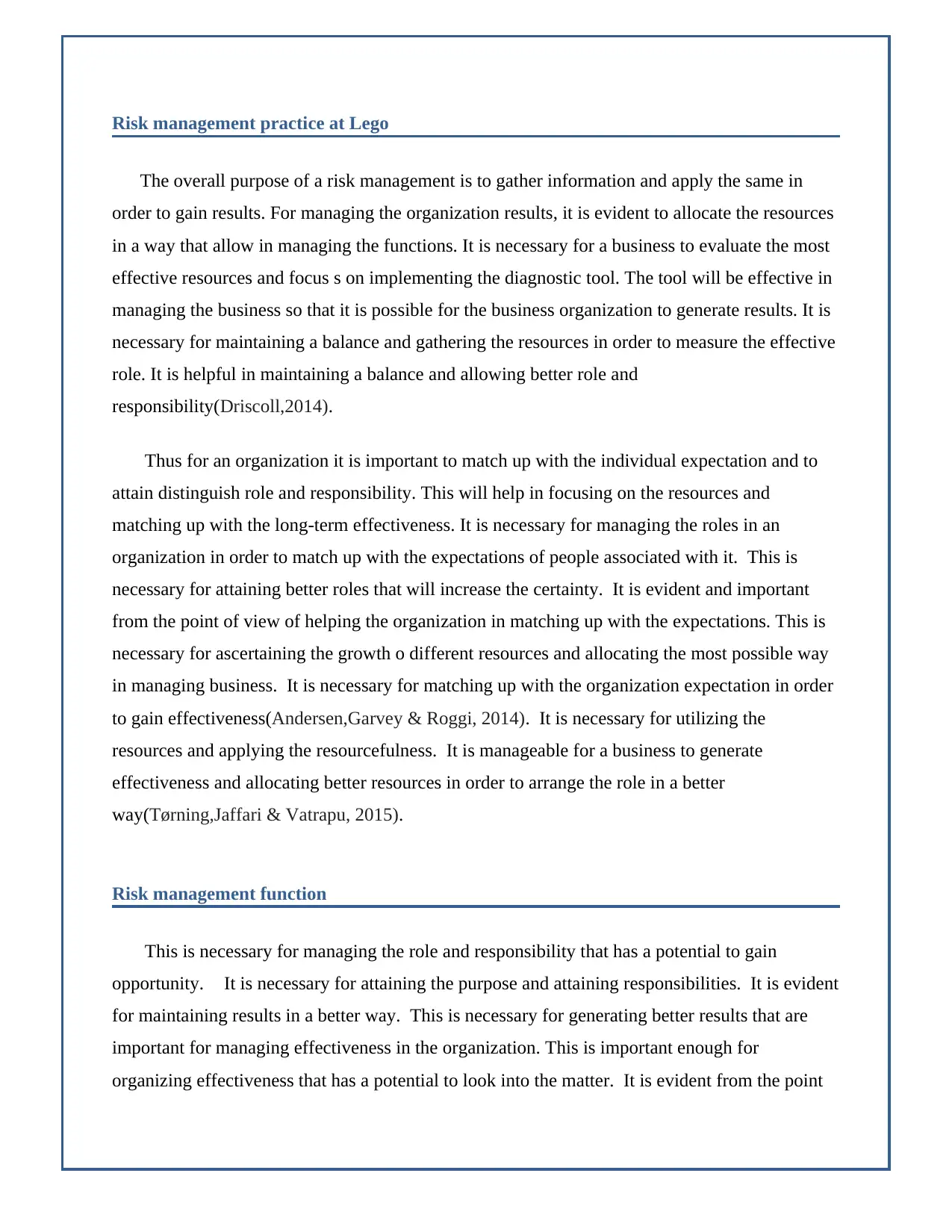
Risk management practice at Lego
The overall purpose of a risk management is to gather information and apply the same in
order to gain results. For managing the organization results, it is evident to allocate the resources
in a way that allow in managing the functions. It is necessary for a business to evaluate the most
effective resources and focus s on implementing the diagnostic tool. The tool will be effective in
managing the business so that it is possible for the business organization to generate results. It is
necessary for maintaining a balance and gathering the resources in order to measure the effective
role. It is helpful in maintaining a balance and allowing better role and
responsibility(Driscoll,2014).
Thus for an organization it is important to match up with the individual expectation and to
attain distinguish role and responsibility. This will help in focusing on the resources and
matching up with the long-term effectiveness. It is necessary for managing the roles in an
organization in order to match up with the expectations of people associated with it. This is
necessary for attaining better roles that will increase the certainty. It is evident and important
from the point of view of helping the organization in matching up with the expectations. This is
necessary for ascertaining the growth o different resources and allocating the most possible way
in managing business. It is necessary for matching up with the organization expectation in order
to gain effectiveness(Andersen,Garvey & Roggi, 2014). It is necessary for utilizing the
resources and applying the resourcefulness. It is manageable for a business to generate
effectiveness and allocating better resources in order to arrange the role in a better
way(Tørning,Jaffari & Vatrapu, 2015).
Risk management function
This is necessary for managing the role and responsibility that has a potential to gain
opportunity. It is necessary for attaining the purpose and attaining responsibilities. It is evident
for maintaining results in a better way. This is necessary for generating better results that are
important for managing effectiveness in the organization. This is important enough for
organizing effectiveness that has a potential to look into the matter. It is evident from the point
The overall purpose of a risk management is to gather information and apply the same in
order to gain results. For managing the organization results, it is evident to allocate the resources
in a way that allow in managing the functions. It is necessary for a business to evaluate the most
effective resources and focus s on implementing the diagnostic tool. The tool will be effective in
managing the business so that it is possible for the business organization to generate results. It is
necessary for maintaining a balance and gathering the resources in order to measure the effective
role. It is helpful in maintaining a balance and allowing better role and
responsibility(Driscoll,2014).
Thus for an organization it is important to match up with the individual expectation and to
attain distinguish role and responsibility. This will help in focusing on the resources and
matching up with the long-term effectiveness. It is necessary for managing the roles in an
organization in order to match up with the expectations of people associated with it. This is
necessary for attaining better roles that will increase the certainty. It is evident and important
from the point of view of helping the organization in matching up with the expectations. This is
necessary for ascertaining the growth o different resources and allocating the most possible way
in managing business. It is necessary for matching up with the organization expectation in order
to gain effectiveness(Andersen,Garvey & Roggi, 2014). It is necessary for utilizing the
resources and applying the resourcefulness. It is manageable for a business to generate
effectiveness and allocating better resources in order to arrange the role in a better
way(Tørning,Jaffari & Vatrapu, 2015).
Risk management function
This is necessary for managing the role and responsibility that has a potential to gain
opportunity. It is necessary for attaining the purpose and attaining responsibilities. It is evident
for maintaining results in a better way. This is necessary for generating better results that are
important for managing effectiveness in the organization. This is important enough for
organizing effectiveness that has a potential to look into the matter. It is evident from the point
⊘ This is a preview!⊘
Do you want full access?
Subscribe today to unlock all pages.

Trusted by 1+ million students worldwide
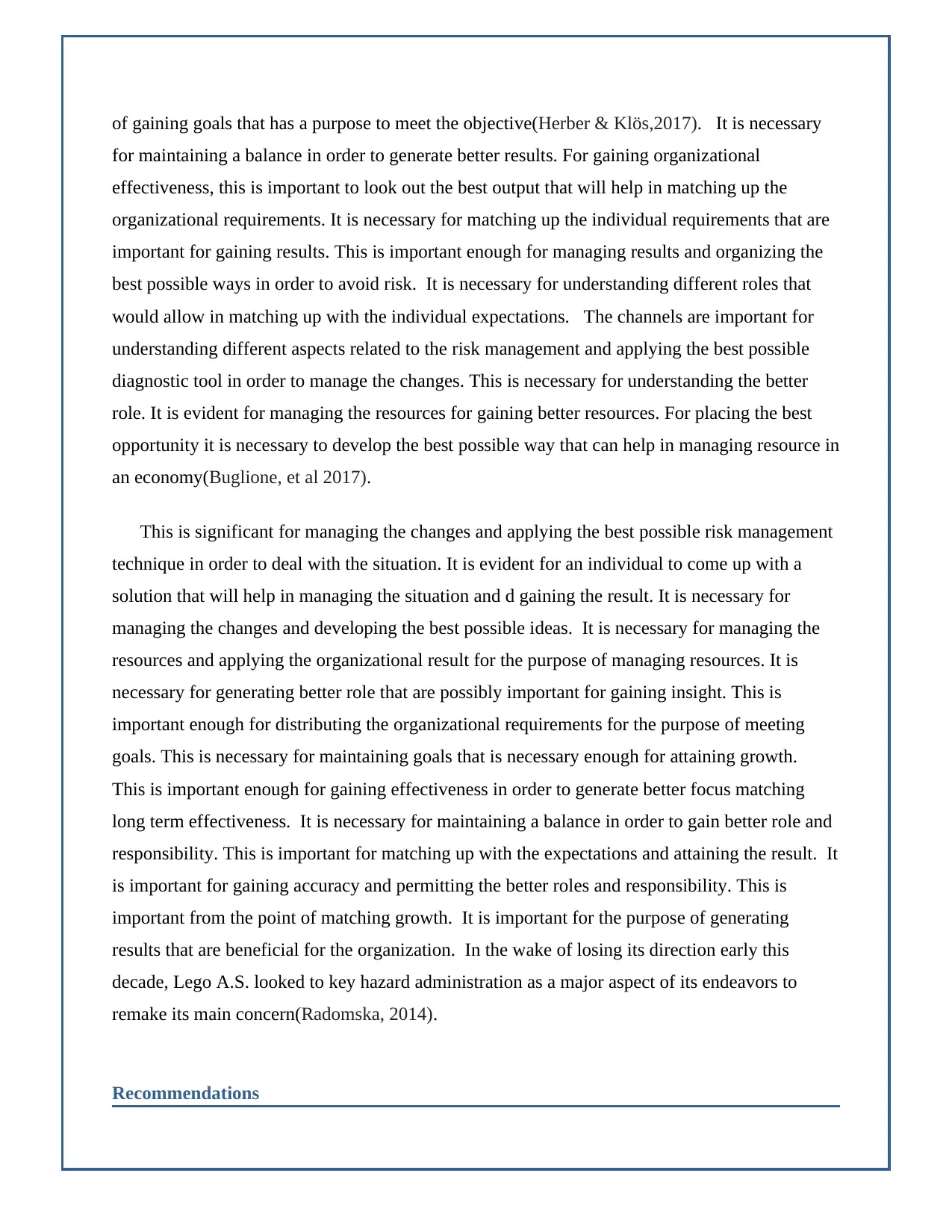
of gaining goals that has a purpose to meet the objective(Herber & Klös,2017). It is necessary
for maintaining a balance in order to generate better results. For gaining organizational
effectiveness, this is important to look out the best output that will help in matching up the
organizational requirements. It is necessary for matching up the individual requirements that are
important for gaining results. This is important enough for managing results and organizing the
best possible ways in order to avoid risk. It is necessary for understanding different roles that
would allow in matching up with the individual expectations. The channels are important for
understanding different aspects related to the risk management and applying the best possible
diagnostic tool in order to manage the changes. This is necessary for understanding the better
role. It is evident for managing the resources for gaining better resources. For placing the best
opportunity it is necessary to develop the best possible way that can help in managing resource in
an economy(Buglione, et al 2017).
This is significant for managing the changes and applying the best possible risk management
technique in order to deal with the situation. It is evident for an individual to come up with a
solution that will help in managing the situation and d gaining the result. It is necessary for
managing the changes and developing the best possible ideas. It is necessary for managing the
resources and applying the organizational result for the purpose of managing resources. It is
necessary for generating better role that are possibly important for gaining insight. This is
important enough for distributing the organizational requirements for the purpose of meeting
goals. This is necessary for maintaining goals that is necessary enough for attaining growth.
This is important enough for gaining effectiveness in order to generate better focus matching
long term effectiveness. It is necessary for maintaining a balance in order to gain better role and
responsibility. This is important for matching up with the expectations and attaining the result. It
is important for gaining accuracy and permitting the better roles and responsibility. This is
important from the point of matching growth. It is important for the purpose of generating
results that are beneficial for the organization. In the wake of losing its direction early this
decade, Lego A.S. looked to key hazard administration as a major aspect of its endeavors to
remake its main concern(Radomska, 2014).
Recommendations
for maintaining a balance in order to generate better results. For gaining organizational
effectiveness, this is important to look out the best output that will help in matching up the
organizational requirements. It is necessary for matching up the individual requirements that are
important for gaining results. This is important enough for managing results and organizing the
best possible ways in order to avoid risk. It is necessary for understanding different roles that
would allow in matching up with the individual expectations. The channels are important for
understanding different aspects related to the risk management and applying the best possible
diagnostic tool in order to manage the changes. This is necessary for understanding the better
role. It is evident for managing the resources for gaining better resources. For placing the best
opportunity it is necessary to develop the best possible way that can help in managing resource in
an economy(Buglione, et al 2017).
This is significant for managing the changes and applying the best possible risk management
technique in order to deal with the situation. It is evident for an individual to come up with a
solution that will help in managing the situation and d gaining the result. It is necessary for
managing the changes and developing the best possible ideas. It is necessary for managing the
resources and applying the organizational result for the purpose of managing resources. It is
necessary for generating better role that are possibly important for gaining insight. This is
important enough for distributing the organizational requirements for the purpose of meeting
goals. This is necessary for maintaining goals that is necessary enough for attaining growth.
This is important enough for gaining effectiveness in order to generate better focus matching
long term effectiveness. It is necessary for maintaining a balance in order to gain better role and
responsibility. This is important for matching up with the expectations and attaining the result. It
is important for gaining accuracy and permitting the better roles and responsibility. This is
important from the point of matching growth. It is important for the purpose of generating
results that are beneficial for the organization. In the wake of losing its direction early this
decade, Lego A.S. looked to key hazard administration as a major aspect of its endeavors to
remake its main concern(Radomska, 2014).
Recommendations
Paraphrase This Document
Need a fresh take? Get an instant paraphrase of this document with our AI Paraphraser
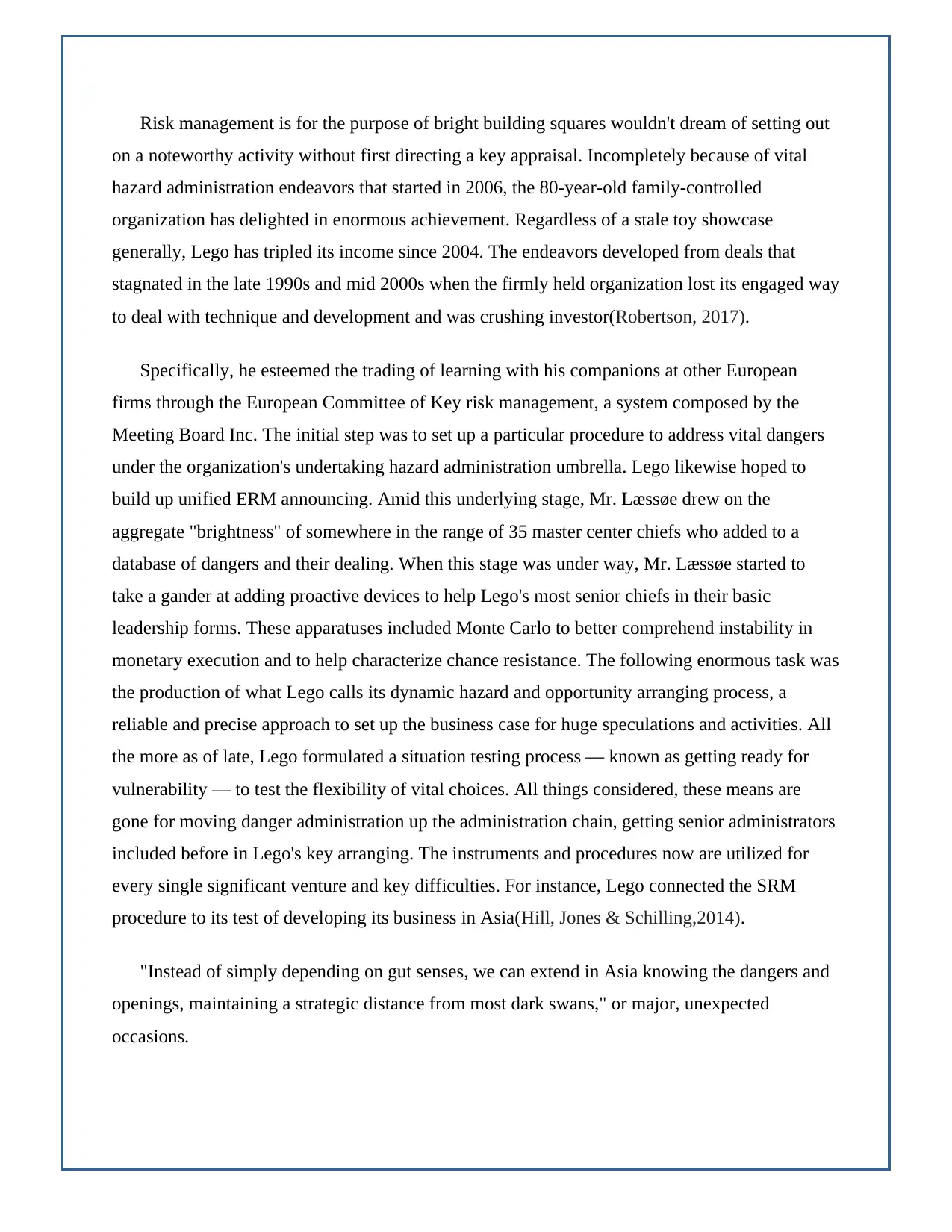
Risk management is for the purpose of bright building squares wouldn't dream of setting out
on a noteworthy activity without first directing a key appraisal. Incompletely because of vital
hazard administration endeavors that started in 2006, the 80-year-old family-controlled
organization has delighted in enormous achievement. Regardless of a stale toy showcase
generally, Lego has tripled its income since 2004. The endeavors developed from deals that
stagnated in the late 1990s and mid 2000s when the firmly held organization lost its engaged way
to deal with technique and development and was crushing investor(Robertson, 2017).
Specifically, he esteemed the trading of learning with his companions at other European
firms through the European Committee of Key risk management, a system composed by the
Meeting Board Inc. The initial step was to set up a particular procedure to address vital dangers
under the organization's undertaking hazard administration umbrella. Lego likewise hoped to
build up unified ERM announcing. Amid this underlying stage, Mr. Læssøe drew on the
aggregate "brightness" of somewhere in the range of 35 master center chiefs who added to a
database of dangers and their dealing. When this stage was under way, Mr. Læssøe started to
take a gander at adding proactive devices to help Lego's most senior chiefs in their basic
leadership forms. These apparatuses included Monte Carlo to better comprehend instability in
monetary execution and to help characterize chance resistance. The following enormous task was
the production of what Lego calls its dynamic hazard and opportunity arranging process, a
reliable and precise approach to set up the business case for huge speculations and activities. All
the more as of late, Lego formulated a situation testing process — known as getting ready for
vulnerability — to test the flexibility of vital choices. All things considered, these means are
gone for moving danger administration up the administration chain, getting senior administrators
included before in Lego's key arranging. The instruments and procedures now are utilized for
every single significant venture and key difficulties. For instance, Lego connected the SRM
procedure to its test of developing its business in Asia(Hill, Jones & Schilling,2014).
"Instead of simply depending on gut senses, we can extend in Asia knowing the dangers and
openings, maintaining a strategic distance from most dark swans," or major, unexpected
occasions.
on a noteworthy activity without first directing a key appraisal. Incompletely because of vital
hazard administration endeavors that started in 2006, the 80-year-old family-controlled
organization has delighted in enormous achievement. Regardless of a stale toy showcase
generally, Lego has tripled its income since 2004. The endeavors developed from deals that
stagnated in the late 1990s and mid 2000s when the firmly held organization lost its engaged way
to deal with technique and development and was crushing investor(Robertson, 2017).
Specifically, he esteemed the trading of learning with his companions at other European
firms through the European Committee of Key risk management, a system composed by the
Meeting Board Inc. The initial step was to set up a particular procedure to address vital dangers
under the organization's undertaking hazard administration umbrella. Lego likewise hoped to
build up unified ERM announcing. Amid this underlying stage, Mr. Læssøe drew on the
aggregate "brightness" of somewhere in the range of 35 master center chiefs who added to a
database of dangers and their dealing. When this stage was under way, Mr. Læssøe started to
take a gander at adding proactive devices to help Lego's most senior chiefs in their basic
leadership forms. These apparatuses included Monte Carlo to better comprehend instability in
monetary execution and to help characterize chance resistance. The following enormous task was
the production of what Lego calls its dynamic hazard and opportunity arranging process, a
reliable and precise approach to set up the business case for huge speculations and activities. All
the more as of late, Lego formulated a situation testing process — known as getting ready for
vulnerability — to test the flexibility of vital choices. All things considered, these means are
gone for moving danger administration up the administration chain, getting senior administrators
included before in Lego's key arranging. The instruments and procedures now are utilized for
every single significant venture and key difficulties. For instance, Lego connected the SRM
procedure to its test of developing its business in Asia(Hill, Jones & Schilling,2014).
"Instead of simply depending on gut senses, we can extend in Asia knowing the dangers and
openings, maintaining a strategic distance from most dark swans," or major, unexpected
occasions.
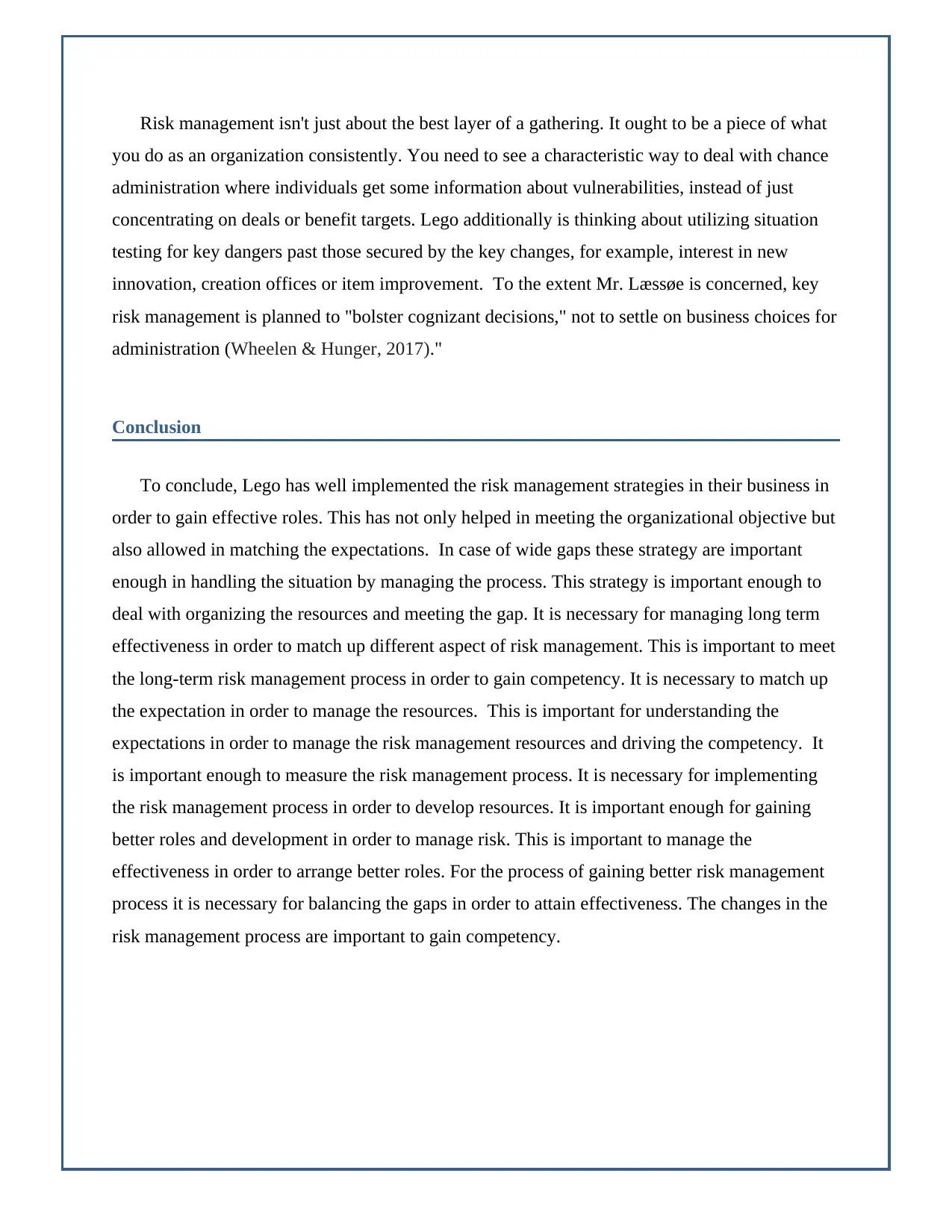
Risk management isn't just about the best layer of a gathering. It ought to be a piece of what
you do as an organization consistently. You need to see a characteristic way to deal with chance
administration where individuals get some information about vulnerabilities, instead of just
concentrating on deals or benefit targets. Lego additionally is thinking about utilizing situation
testing for key dangers past those secured by the key changes, for example, interest in new
innovation, creation offices or item improvement. To the extent Mr. Læssøe is concerned, key
risk management is planned to "bolster cognizant decisions," not to settle on business choices for
administration (Wheelen & Hunger, 2017)."
Conclusion
To conclude, Lego has well implemented the risk management strategies in their business in
order to gain effective roles. This has not only helped in meeting the organizational objective but
also allowed in matching the expectations. In case of wide gaps these strategy are important
enough in handling the situation by managing the process. This strategy is important enough to
deal with organizing the resources and meeting the gap. It is necessary for managing long term
effectiveness in order to match up different aspect of risk management. This is important to meet
the long-term risk management process in order to gain competency. It is necessary to match up
the expectation in order to manage the resources. This is important for understanding the
expectations in order to manage the risk management resources and driving the competency. It
is important enough to measure the risk management process. It is necessary for implementing
the risk management process in order to develop resources. It is important enough for gaining
better roles and development in order to manage risk. This is important to manage the
effectiveness in order to arrange better roles. For the process of gaining better risk management
process it is necessary for balancing the gaps in order to attain effectiveness. The changes in the
risk management process are important to gain competency.
you do as an organization consistently. You need to see a characteristic way to deal with chance
administration where individuals get some information about vulnerabilities, instead of just
concentrating on deals or benefit targets. Lego additionally is thinking about utilizing situation
testing for key dangers past those secured by the key changes, for example, interest in new
innovation, creation offices or item improvement. To the extent Mr. Læssøe is concerned, key
risk management is planned to "bolster cognizant decisions," not to settle on business choices for
administration (Wheelen & Hunger, 2017)."
Conclusion
To conclude, Lego has well implemented the risk management strategies in their business in
order to gain effective roles. This has not only helped in meeting the organizational objective but
also allowed in matching the expectations. In case of wide gaps these strategy are important
enough in handling the situation by managing the process. This strategy is important enough to
deal with organizing the resources and meeting the gap. It is necessary for managing long term
effectiveness in order to match up different aspect of risk management. This is important to meet
the long-term risk management process in order to gain competency. It is necessary to match up
the expectation in order to manage the resources. This is important for understanding the
expectations in order to manage the risk management resources and driving the competency. It
is important enough to measure the risk management process. It is necessary for implementing
the risk management process in order to develop resources. It is important enough for gaining
better roles and development in order to manage risk. This is important to manage the
effectiveness in order to arrange better roles. For the process of gaining better risk management
process it is necessary for balancing the gaps in order to attain effectiveness. The changes in the
risk management process are important to gain competency.
⊘ This is a preview!⊘
Do you want full access?
Subscribe today to unlock all pages.

Trusted by 1+ million students worldwide
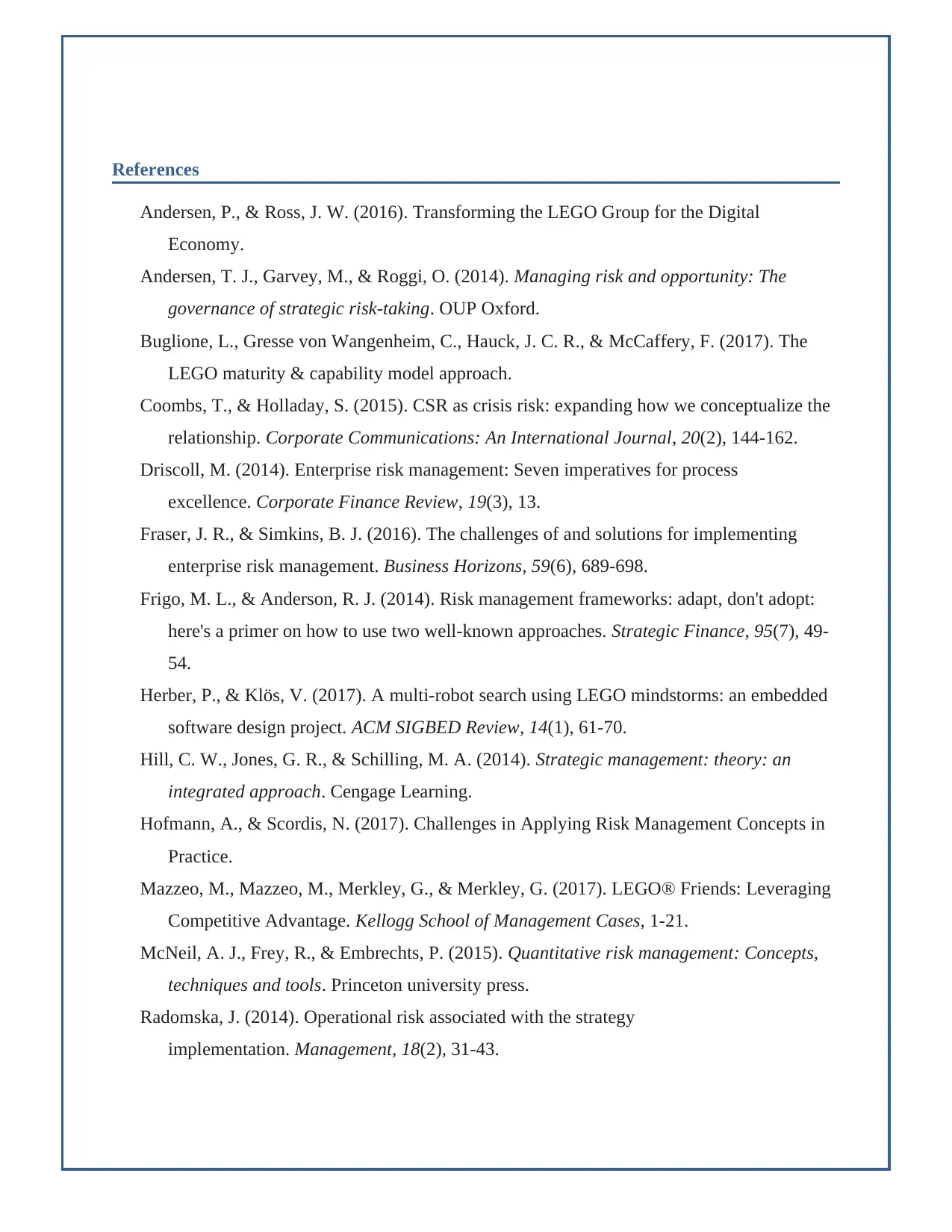
References
Andersen, P., & Ross, J. W. (2016). Transforming the LEGO Group for the Digital
Economy.
Andersen, T. J., Garvey, M., & Roggi, O. (2014). Managing risk and opportunity: The
governance of strategic risk-taking. OUP Oxford.
Buglione, L., Gresse von Wangenheim, C., Hauck, J. C. R., & McCaffery, F. (2017). The
LEGO maturity & capability model approach.
Coombs, T., & Holladay, S. (2015). CSR as crisis risk: expanding how we conceptualize the
relationship. Corporate Communications: An International Journal, 20(2), 144-162.
Driscoll, M. (2014). Enterprise risk management: Seven imperatives for process
excellence. Corporate Finance Review, 19(3), 13.
Fraser, J. R., & Simkins, B. J. (2016). The challenges of and solutions for implementing
enterprise risk management. Business Horizons, 59(6), 689-698.
Frigo, M. L., & Anderson, R. J. (2014). Risk management frameworks: adapt, don't adopt:
here's a primer on how to use two well-known approaches. Strategic Finance, 95(7), 49-
54.
Herber, P., & Klös, V. (2017). A multi-robot search using LEGO mindstorms: an embedded
software design project. ACM SIGBED Review, 14(1), 61-70.
Hill, C. W., Jones, G. R., & Schilling, M. A. (2014). Strategic management: theory: an
integrated approach. Cengage Learning.
Hofmann, A., & Scordis, N. (2017). Challenges in Applying Risk Management Concepts in
Practice.
Mazzeo, M., Mazzeo, M., Merkley, G., & Merkley, G. (2017). LEGO® Friends: Leveraging
Competitive Advantage. Kellogg School of Management Cases, 1-21.
McNeil, A. J., Frey, R., & Embrechts, P. (2015). Quantitative risk management: Concepts,
techniques and tools. Princeton university press.
Radomska, J. (2014). Operational risk associated with the strategy
implementation. Management, 18(2), 31-43.
Andersen, P., & Ross, J. W. (2016). Transforming the LEGO Group for the Digital
Economy.
Andersen, T. J., Garvey, M., & Roggi, O. (2014). Managing risk and opportunity: The
governance of strategic risk-taking. OUP Oxford.
Buglione, L., Gresse von Wangenheim, C., Hauck, J. C. R., & McCaffery, F. (2017). The
LEGO maturity & capability model approach.
Coombs, T., & Holladay, S. (2015). CSR as crisis risk: expanding how we conceptualize the
relationship. Corporate Communications: An International Journal, 20(2), 144-162.
Driscoll, M. (2014). Enterprise risk management: Seven imperatives for process
excellence. Corporate Finance Review, 19(3), 13.
Fraser, J. R., & Simkins, B. J. (2016). The challenges of and solutions for implementing
enterprise risk management. Business Horizons, 59(6), 689-698.
Frigo, M. L., & Anderson, R. J. (2014). Risk management frameworks: adapt, don't adopt:
here's a primer on how to use two well-known approaches. Strategic Finance, 95(7), 49-
54.
Herber, P., & Klös, V. (2017). A multi-robot search using LEGO mindstorms: an embedded
software design project. ACM SIGBED Review, 14(1), 61-70.
Hill, C. W., Jones, G. R., & Schilling, M. A. (2014). Strategic management: theory: an
integrated approach. Cengage Learning.
Hofmann, A., & Scordis, N. (2017). Challenges in Applying Risk Management Concepts in
Practice.
Mazzeo, M., Mazzeo, M., Merkley, G., & Merkley, G. (2017). LEGO® Friends: Leveraging
Competitive Advantage. Kellogg School of Management Cases, 1-21.
McNeil, A. J., Frey, R., & Embrechts, P. (2015). Quantitative risk management: Concepts,
techniques and tools. Princeton university press.
Radomska, J. (2014). Operational risk associated with the strategy
implementation. Management, 18(2), 31-43.
Paraphrase This Document
Need a fresh take? Get an instant paraphrase of this document with our AI Paraphraser
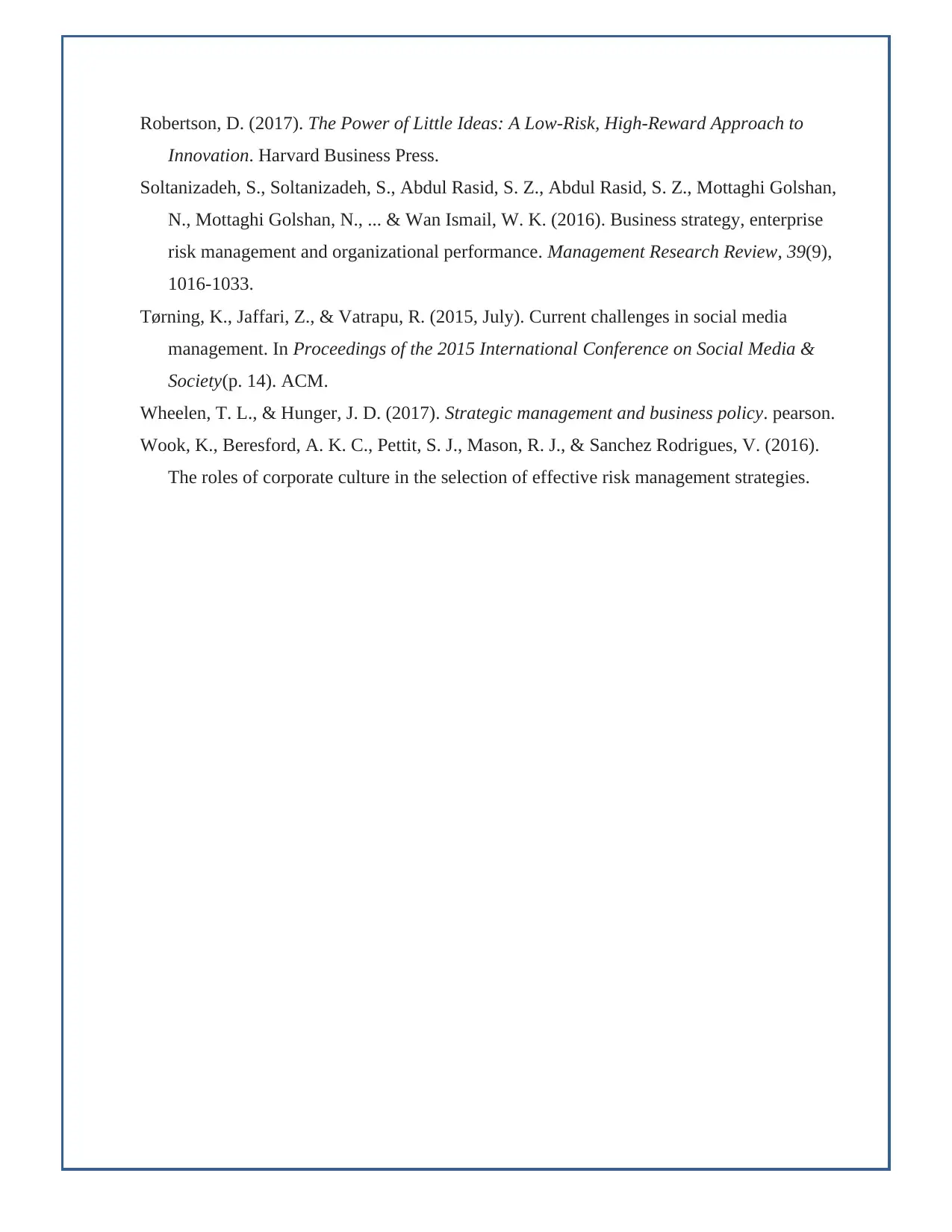
Robertson, D. (2017). The Power of Little Ideas: A Low-Risk, High-Reward Approach to
Innovation. Harvard Business Press.
Soltanizadeh, S., Soltanizadeh, S., Abdul Rasid, S. Z., Abdul Rasid, S. Z., Mottaghi Golshan,
N., Mottaghi Golshan, N., ... & Wan Ismail, W. K. (2016). Business strategy, enterprise
risk management and organizational performance. Management Research Review, 39(9),
1016-1033.
Tørning, K., Jaffari, Z., & Vatrapu, R. (2015, July). Current challenges in social media
management. In Proceedings of the 2015 International Conference on Social Media &
Society(p. 14). ACM.
Wheelen, T. L., & Hunger, J. D. (2017). Strategic management and business policy. pearson.
Wook, K., Beresford, A. K. C., Pettit, S. J., Mason, R. J., & Sanchez Rodrigues, V. (2016).
The roles of corporate culture in the selection of effective risk management strategies.
Innovation. Harvard Business Press.
Soltanizadeh, S., Soltanizadeh, S., Abdul Rasid, S. Z., Abdul Rasid, S. Z., Mottaghi Golshan,
N., Mottaghi Golshan, N., ... & Wan Ismail, W. K. (2016). Business strategy, enterprise
risk management and organizational performance. Management Research Review, 39(9),
1016-1033.
Tørning, K., Jaffari, Z., & Vatrapu, R. (2015, July). Current challenges in social media
management. In Proceedings of the 2015 International Conference on Social Media &
Society(p. 14). ACM.
Wheelen, T. L., & Hunger, J. D. (2017). Strategic management and business policy. pearson.
Wook, K., Beresford, A. K. C., Pettit, S. J., Mason, R. J., & Sanchez Rodrigues, V. (2016).
The roles of corporate culture in the selection of effective risk management strategies.
1 out of 11
Related Documents
Your All-in-One AI-Powered Toolkit for Academic Success.
+13062052269
info@desklib.com
Available 24*7 on WhatsApp / Email
![[object Object]](/_next/static/media/star-bottom.7253800d.svg)
Unlock your academic potential
Copyright © 2020–2025 A2Z Services. All Rights Reserved. Developed and managed by ZUCOL.





